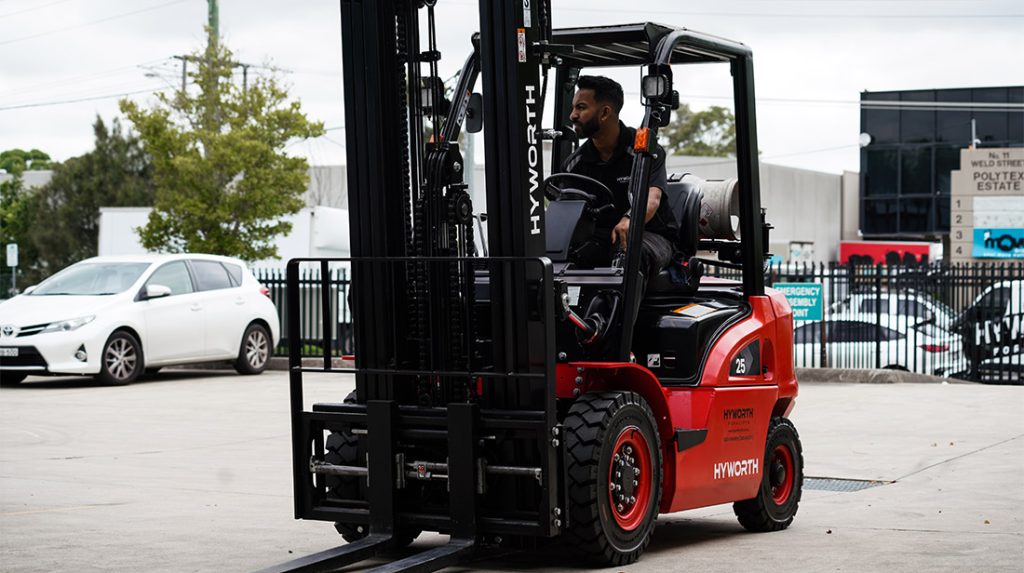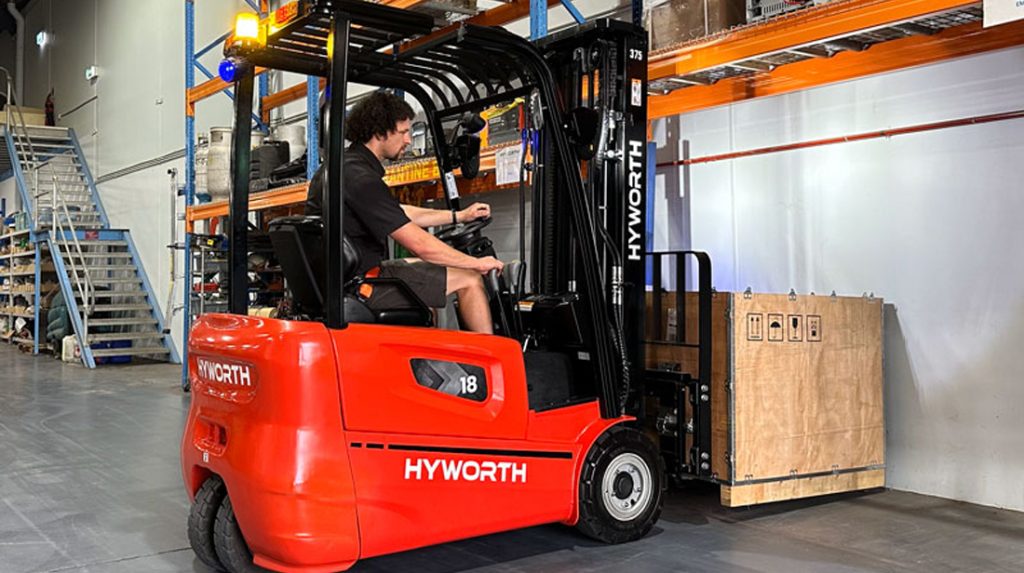
In any warehouse or construction site, safety is the foundation of productivity. Forklift operators are trained to lift, move, and store heavy loads with precision, but sometimes, the most serious injuries occur in the simplest moments: getting on and off the machine. That’s where the three-point contact rule for forklifts comes into play.
This simple yet essential rule helps prevent slips, trips, and falls—the most common cause of workplace injuries in Australia. Whether you’re operating a large LPG forklift outdoors or a compact walk-behind unit in a tight warehouse aisle, knowing and applying this rule could save you from a painful accident.
Let’s explore what this rule means, why it matters, and how Hyworth Forklifts supports safer practices through operator-first equipment design.
What is the Three-Point Contact Rule for a Forklift?
The three-point contact rule for a forklift is a key safety principle used when entering or exiting a forklift. It means keeping three of your four limbs in contact with the vehicle at all times—either two hands and one foot, or two feet and one hand.
This creates a “triangle of stability,” which distributes your weight evenly and helps maintain balance. The idea is to reduce your risk of falling by keeping constant contact with the machine. If you lose grip or footing, the other two points of contact can help you recover safely.
It’s not just about grip, it’s about maintaining full control during mounting and dismounting, which is when most slips and falls tend to occur.
Importantly, you must always face the forklift during this process. Turning your back or twisting mid-step breaks the rule and increases the risk of injury.
Why is the three-point contact rule crucial for forklift operators?
Falls from forklifts don’t just happen when lifting loads. Many injuries occur during routine activities like hopping off the machine for a break or stepping up to begin a shift.
The three-point contact rule for a forklift minimises this risk by providing the body with more control and stability. It keeps your centre of gravity low and your balance steady. For operators dealing with repetitive climbs in and out of machines, this small habit plays a big role in long-term joint health and injury prevention.
According to workplace safety studies, slips, trips, and falls account for about one-third of all reported injuries. In a warehouse environment, even a short fall can lead to broken bones, sprains, or long-term strain.
By following this rule, operators contribute to a safer workspace for themselves and those around them.
When should the three-point contact rule be used?
The rule should be used every single time you:
- Climb onto or off a forklift
- Step onto walk-behind or electric pallet movers
- Access high-reach forklift cabins
- Get in or out of LPG or electric counterbalance forklifts

Even though Hyworth’s forklifts are designed with user-friendly steps and grab handles, complacency can lead to shortcuts. It only takes one rushed moment to cause a serious injury.
This safety rule also applies to other warehouse scenarios, like ladders or elevated loading platforms. In short, if you’re climbing, you should be thinking in threes—three points of contact at all times.
Correct mounting and dismounting procedures: A step-by-step guide
Here’s a safe and simple way to follow the three-point contact rule for a forklift:
- Before climbing:
Make sure the forklift is stationary, with the handbrake engaged. - Face the forklift:
Always face the machine when mounting or dismounting. Never twist your body. - Use the handgrips and steps provided:
Hyworth forklifts are designed with accessible entry points—use them. - Maintain three points of contact:
Either two hands and one foot, or two feet and one hand, at all times. - Keep hands free:
Don’t carry tools, drinks, or devices while mounting. Use a belt or a bag. - Step down—don’t jump:
Always step down slowly, one foot at a time. - Check surfaces for hazards:
Watch out for wet, oily, or uneven steps.
By sticking to this process, you greatly reduce the chance of losing your balance or injuring yourself.
Common mistakes operators make – and how to avoid them
Even experienced operators sometimes fall into bad habits. Here are the most common mistakes, and how to prevent them:
- Jumping off the forklift
This puts stress on knees and ankles and increases the chance of falling or slipping. - Carrying items in hand
This limits your ability to grip the machine properly. Always use both hands if possible. - Turning mid-dismount
Twisting while stepping down disrupts your balance. Always face the forklift. - Ignoring slippery steps
Always check for spills, mud, or water before climbing up or down. - Wearing loose or inappropriate clothing
Loose clothing can snag on levers or handles. Stick to fitted workwear.
These might seem like small errors, but they’re often the root cause of serious injuries.
How employers can support safer work practices
Operators play a role in safety, but so do employers. Here’s how businesses can ensure their teams follow the three-point contact rule for a forklift:
- Provide training
Include the rule in induction and refresher safety training sessions. - Maintain all entry and exit points
Steps and handholds should be checked regularly for wear or damage. - Apply non-slip surfaces
Use anti-slip tape or mats on common entry points. - Install safety signage
Reminder signs near the operator’s seat or door help build good habits. - Choose operator-friendly equipment
Hyworth forklifts are built with safety in mind, featuring easy access steps, ergonomic designs, and customisable entry aids.
Workplace culture also plays a huge part encouraging staff to take their time and put safety first can make all the difference.
Benefits of following the three-point contact rule
Building a culture of safety starts with small habits. Here’s why the three-point contact rule for a forklift matters:
- Fewer injuries
Prevents minor slips from turning into major injuries. - Lower insurance and compensation claims
A safer workplace means fewer costs for everyone. - Less downtime
Healthy operators mean more consistent output. - Longer equipment life
Jumping off equipment can cause impact damage—proper use keeps machines in top shape. - Boosted team morale
When staff feel safe, they’re more confident and productive.
Hyworth’s commitment to operator safety and training
At Hyworth, we design every forklift with the operator in mind. From anti-slip steps to well-positioned grab handles, our machines make it easy to follow the three-point contact rule for a forklift.
Our hire and sales teams go beyond just supplying equipment, we provide expert advice to help customers select the safest and most efficient model for their site. Whether you’re navigating tight aisles with an electric reach truck or unloading heavy goods with an LPG forklift, we’re here to ensure you’ve got the tools and training you need.

Plus, all our forklifts are maintained to high standards, so you can rely on safety features working when you need them most.
Conclusion
The three-point contact rule for a forklift may sound basic, but it’s a game-changer for workplace safety. It’s quick, easy to follow, and highly effective at reducing preventable injuries.
Whether you’re new to forklift operation or a seasoned professional, taking those extra few seconds to mount and dismount properly can protect your body and your future.
If you’re looking to improve forklift safety at your site or are in the market to buy or hire a reliable forklift, reach out to the team at Hyworth Forklifts. We offer a wide range of operator-friendly equipment and flexible hire options to suit your needs. We’re here to help you move smarter and safer every step of the way.
FAQs About the Three-Point Contact Rule for a Forklift
1. What is the three-point contact rule for a forklift operators?
It’s a safety practice that requires forklift operators to keep three limbs in contact with the machine at all times when entering or exiting.
2. Why is it important to face the forklift while mounting or dismounting?
Facing the forklift helps maintain balance and control, reducing the risk of falls.
3. Can I carry tools while getting on or off the forklift?
No. Your hands should be free to grip the machine—use a belt or bag instead.
4. Is the three-point contact rule required in Australia?
While not a legal requirement, it’s considered a best practice and part of most workplace safety training programs.
5. Does the rule apply to all types of forklifts?
Yes. Whether it’s a walk-behind, reach truck, or LPG forklift, the rule always applies when climbing on or off.